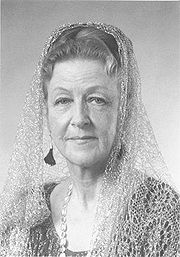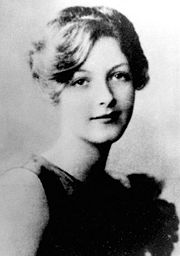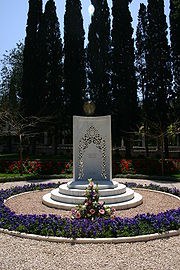
Rúhíyyih Khanum
Encyclopedia

Shoghi Effendi
Shoghí Effendí Rabbání , better known as Shoghi Effendi, was the Guardian and appointed head of the Bahá'í Faith from 1921 until his death in 1957...
, the head of the Bahá'í Faith
Bahá'í Faith
The Bahá'í Faith is a monotheistic religion founded by Bahá'u'lláh in 19th-century Persia, emphasizing the spiritual unity of all humankind. There are an estimated five to six million Bahá'ís around the world in more than 200 countries and territories....
from 1921–1957. She was appointed by him as a Hand of the Cause
Hands of the Cause
The Hands of the Cause of God, Hands of the Cause, or Hands were a select group of Bahá'ís, appointed for life, whose main function was to propagate and protect the Bahá'í Faith...
, and served an important role in the transfer of authority from 1957–1963. In 2004, CBC
Canadian Broadcasting Corporation
The Canadian Broadcasting Corporation, commonly known as CBC and officially as CBC/Radio-Canada, is a Canadian crown corporation that serves as the national public radio and television broadcaster...
viewers voted her number 44 on the list of "greatest Canadians" on the television show The Greatest Canadian
The Greatest Canadian
Officially launched on April 5, 2004, The Greatest Canadian was a television program series by the Canadian Broadcasting Corporation to determine who is considered to be the greatest Canadian of all time, at least among those who watched and participated in the program...
.
Early life

New York City
New York is the most populous city in the United States and the center of the New York Metropolitan Area, one of the most populous metropolitan areas in the world. New York exerts a significant impact upon global commerce, finance, media, art, fashion, research, technology, education, and...
on August 8, 1910 to William Sutherland Maxwell
William Sutherland Maxwell
William Sutherland Maxwell was a well-known Canadian architect and a Hand of the Cause in the Bahá'í Faith. He was born in Montreal, Canada to parents Edward John Maxwell and Johan MacBean.-Education:...
and May Maxwell
May Maxwell
Mary "May" Maxwell , an early American member of the Bahá'í Faith.-Early life:...
, and was raised in Montreal
Montreal
Montreal is a city in Canada. It is the largest city in the province of Quebec, the second-largest city in Canada and the seventh largest in North America...
, Québec
Quebec
Quebec or is a province in east-central Canada. It is the only Canadian province with a predominantly French-speaking population and the only one whose sole official language is French at the provincial level....
where her father was an architect. Mary was of Scottish ancestry. In 1912 `Abdu'l-Bahá
`Abdu'l-Bahá
‘Abdu’l-Bahá , born ‘Abbás Effendí, was the eldest son of Bahá'u'lláh, the founder of the Bahá'í Faith. In 1892, `Abdu'l-Bahá was appointed in his father's will to be his successor and head of the Bahá'í Faith. `Abdu'l-Bahá was born in Tehran to an aristocratic family of the realm...
visited Canada and stayed in the Maxwell’s home. There he met Mary, aged two, and described her as the "essence of sweetness". `Abdu'l-Bahá showed much affection to baby Mary.
Her mother wanted to give Mary an education that was free of the rigidity of the traditional educational methods in the country, and established the first Montessori school in Canada at their residence, and Mary attended the school. Maxwell began reading and writing at a young age and her pastimes included writing poetry, novels and plays. She spoke English, French, German and Persian fluently. During her youth she twice traveled to the Bahá'í World Centre
Bahá'í World Centre
The Bahá'í World Centre is the name given to the spiritual and administrative centre of the Bahá'í Faith. The World Centre consists of the Shrine of Bahá'u'lláh near Acre, Israel, the Shrine of the Báb and its gardens on Mount Carmel in Haifa, Israel, and various other buildings in the area...
in Palestine
Palestine
Palestine is a conventional name, among others, used to describe the geographic region between the Mediterranean Sea and the Jordan River, and various adjoining lands....
for pilgrimage
Bahá'í pilgrimage
A Bahá'í pilgrimage currently consists of visiting the holy places in Haifa, Akká, and Bahjí at the Bahá'í World Centre in Northwest Israel. Bahá'ís do not have access to other places designated as sites for pilgrimage....
– the first with her mother and the second with her mother's friends aged sixteen. It was during these pilgrimages that she first met Shoghi Effendi
Shoghi Effendi
Shoghí Effendí Rabbání , better known as Shoghi Effendi, was the Guardian and appointed head of the Bahá'í Faith from 1921 until his death in 1957...
, the Guardian of the Bahá'í Faith.
After her trips she also engaged in many youth activities in the Bahá'í community, and traveled around the world teaching the Bahá'í Faith.
In her youth Maxwell was engaged in many Bahá’í youth activities. At the age of 15 she joined the Executive Committee of the Fellowship of Canadian Youth for Peace. She was also involved in local racial equality conventions including dances. A spectator – one of the first African-American Bahá’ís – Sadie Oglesby described her as "sixteen-year-old Mary Maxwell, a beautiful and most refreshing girl to know". By twenty-one she was elected to the local Spiritual Assembly
Spiritual Assembly
Spiritual Assembly is a term given by `Abdu'l-Bahá to refer to elected councils that govern the Bahá'í Faith. Because the Bahá'í Faith has no clergy, they carry out the affairs of the community...
of the Bahá'ís of Montreal, the local Bahá'í governing council there.
Marriage and appointed positions
Mary and Shoghi EffendiShoghi Effendi
Shoghí Effendí Rabbání , better known as Shoghi Effendi, was the Guardian and appointed head of the Bahá'í Faith from 1921 until his death in 1957...
had met on first when she was on her first pilgrimage in 1923, and at 16 she made her second one. She made her third in early 1937 and the two began a discreet courtship. On March 24, 1937 aged twenty-six she married the Guardian of the Bahá'í Faith, Shoghi Effendi
Shoghi Effendi
Shoghí Effendí Rabbání , better known as Shoghi Effendi, was the Guardian and appointed head of the Bahá'í Faith from 1921 until his death in 1957...
, and it was at this time that she was given the name "Amatu'l-Bahá Rúhíyyih Khánum" by Shoghi Effendi. ("Amatu'l-Bahá" means "Handmaiden of Glory".) The marriage ceremony had been deliberately a reserved and simple one. The two became constant companions and Shoghi Effendi later described Rúhíyyih Khánum as his "shield" and his "helpmate".
Almost immediately after their marriage, she served as the Guardian's secretary, and then in 1941 until 1957 she served as Shoghi Effendi's principal secretary in English
English language
English is a West Germanic language that arose in the Anglo-Saxon kingdoms of England and spread into what was to become south-east Scotland under the influence of the Anglian medieval kingdom of Northumbria...
. In 1951 she was appointed to the International Bahá'í Council
International Bahá'í Council
The International Bahá'í Council was an administrative institution of the Bahá'í Faith, first created in 1951 as a precursor to the Universal House of Justice, which replaced it in 1963.-Formation:...
, which was an administrative institution of the Bahá'í Faith created as a precursor to the Universal House of Justice
Universal House of Justice
The Universal House of Justice is the supreme governing institution of the Bahá'í Faith. It is a legislative institution with the authority to supplement and apply the laws of Bahá'u'lláh, the founder of the Bahá'í Faith, and exercises a judicial function as the highest appellate institution in the...
, to act as a liaison between the Council and Shoghi Effendi. Later on March 26, 1952, she was appointed to the office of Hand of the Cause of God
Hands of the Cause
The Hands of the Cause of God, Hands of the Cause, or Hands were a select group of Bahá'ís, appointed for life, whose main function was to propagate and protect the Bahá'í Faith...
– a distinguished rank in service to the religion – for which she attended to issues related to the propagation and protection of the religion.
After Shoghi Effendi died in 1957, she became for Bahá'ís the last remaining link to the family of `Abdu'l-Bahá
`Abdu'l-Bahá
‘Abdu’l-Bahá , born ‘Abbás Effendí, was the eldest son of Bahá'u'lláh, the founder of the Bahá'í Faith. In 1892, `Abdu'l-Bahá was appointed in his father's will to be his successor and head of the Bahá'í Faith. `Abdu'l-Bahá was born in Tehran to an aristocratic family of the realm...
, who headed the Faith from 1892 to 1921 and was the eldest son of the Faith's Founder, Bahá'u'lláh
Bahá'u'lláh
Bahá'u'lláh , born ' , was the founder of the Bahá'í Faith. He claimed to be the prophetic fulfilment of Bábism, a 19th-century outgrowth of Shí‘ism, but in a broader sense claimed to be a messenger from God referring to the fulfilment of the eschatological expectations of Islam, Christianity, and...
.
Ministry of the Custodians
In 1957 her husband, Shoghi Effendi, died without having appointed a successor. Rúhíyyih Khánum was among the 27 Hands of the Cause who stewarded the religion for the six-year interim, before the Universal House of JusticeUniversal House of Justice
The Universal House of Justice is the supreme governing institution of the Bahá'í Faith. It is a legislative institution with the authority to supplement and apply the laws of Bahá'u'lláh, the founder of the Bahá'í Faith, and exercises a judicial function as the highest appellate institution in the...
was scheduled to be elected in 1963. The Hands voted among themselves for nine individuals to work at the Bahá'í World Centre to run the administration of the Faith, a position to which Rúhíyyih Khánum was elected; these nine were designated the Custodians
Custodians
The Custodians is terminology in the Bahá'í Faith, which refers to nine Hands of the Cause assigned specifically to work at the Bahá'í World Centre in attendance to the Guardian of the Faith...
. During this time she worked on assuring the completion of the ten-year international teaching plan which was launched by Shoghi Effendi in 1953. Upon the election of the Universal House of Justice in 1963, the ending point of Shoghi Effendi's ten-year plan, the nine Hands acting as interim head of the Faith closed their office.
Travels

Sub-Saharan Africa
Sub-Saharan Africa as a geographical term refers to the area of the African continent which lies south of the Sahara. A political definition of Sub-Saharan Africa, instead, covers all African countries which are fully or partially located south of the Sahara...
, visiting 34 countries, of which in 17 she was received by the head of state
Head of State
A head of state is the individual that serves as the chief public representative of a monarchy, republic, federation, commonwealth or other kind of state. His or her role generally includes legitimizing the state and exercising the political powers, functions, and duties granted to the head of...
. On another trip she visited nearly 30 countries in Asia
Asia
Asia is the world's largest and most populous continent, located primarily in the eastern and northern hemispheres. It covers 8.7% of the Earth's total surface area and with approximately 3.879 billion people, it hosts 60% of the world's current human population...
and the Pacific islands
Pacific Islands
The Pacific Islands comprise 20,000 to 30,000 islands in the Pacific Ocean. The islands are also sometimes collectively called Oceania, although Oceania is sometimes defined as also including Australasia and the Malay Archipelago....
during a seven month span. From January to March 1970 she crossed Africa from east to west, driving 2/3 of the distance herself, visiting many country's communities, meeting with individuals and institutions both Bahá'í and civic.
In 1975–6 she travelled by boat through the tributaries of the Amazon River
Amazon River
The Amazon of South America is the second longest river in the world and by far the largest by waterflow with an average discharge greater than the next seven largest rivers combined...
of Brazil
Brazil
Brazil , officially the Federative Republic of Brazil , is the largest country in South America. It is the world's fifth largest country, both by geographical area and by population with over 192 million people...
and also visiting the high mountain ranges of Peru
Peru
Peru , officially the Republic of Peru , is a country in western South America. It is bordered on the north by Ecuador and Colombia, on the east by Brazil, on the southeast by Bolivia, on the south by Chile, and on the west by the Pacific Ocean....
and Bolivia
Bolivia
Bolivia officially known as Plurinational State of Bolivia , is a landlocked country in central South America. It is the poorest country in South America...
. Thirty six tribal groups were visited over a period of six months; the trip was called The Green Light Expedition, which followed Khanum's The Great African Safari. There have also been projects developed from the original expedition - In the Footsteps of the Green Light Expedition and Tear of the Clouds.
During her travels she was received by the following heads of state and government; Emperor Haile Selassie of Ethiopia; Malietoa Tanumafili II of Western Samoa; Prime Minister Indira Gandhi
Indira Gandhi
Indira Priyadarshini Gandhara was an Indian politician who served as the third Prime Minister of India for three consecutive terms and a fourth term . She was assassinated by Sikh extremists...
of India; President Félix Houphouët-Boigny
Félix Houphouët-Boigny
Félix Houphouët-Boigny , affectionately called Papa Houphouët or Le Vieux, was the first President of Côte d'Ivoire. Originally a village chief, he worked as a doctor, an administrator of a plantation, and a union leader, before being elected to the French Parliament and serving in a number of...
of Côte d'Ivoire; President Carlos Menem
Carlos Menem
Carlos Saúl Menem is an Argentine politician who was President of Argentina from 1989 to 1999. He is currently an Argentine National Senator for La Rioja Province.-Early life:...
of Argentina; Prime Minister Edward Seaga
Edward Seaga
Edward Philip George Seaga ON PC was the fifth Prime Minister of Jamaica from 1980 to 1989 and Leader of the Jamaica Labour Party from 1974 to 2005. He served as leader of the opposition from 1974 to 1980 and again from 1989 until January 2005...
of Jamaica; and Javier Pérez de Cuellar
Javier Pérez de Cuéllar
Javier Pérez de Cuéllar y de la Guerra is a Peruvian diplomat who served as the fifth Secretary-General of the United Nations from January 1, 1982 to December 31, 1991. He studied in Colegio San Agustín of Lima, and then at Pontificia Universidad Católica del Perú. In 1995, he ran unsuccessfully...
, Secretary-General of the United Nations.
Death
Rúhíyyih Khánum died on January 19, 2000 at the age of 89 in HaifaHaifa
Haifa is the largest city in northern Israel, and the third-largest city in the country, with a population of over 268,000. Another 300,000 people live in towns directly adjacent to the city including the cities of the Krayot, as well as, Tirat Carmel, Daliyat al-Karmel and Nesher...
, Israel
Israel
The State of Israel is a parliamentary republic located in the Middle East, along the eastern shore of the Mediterranean Sea...
and her resting place is at the Bahá'í World Centre.

